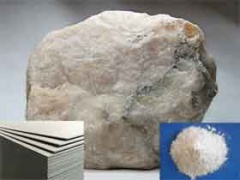Gypsum
| Infobox on Gypsum | |
|---|---|
| Example of Gypsum |  |
| Facts | |
| Origin | - |
| Stowage factor (in m3/t) |
|
| Humidity / moisture | - |
| Ventilation | - |
| Risk factors | See text |
Gypsum
Description / Application
Gypsum is a very soft mineral composed of calcium sulfate dehydrate. It is found in alabaster, a decorative stone used in Ancient Egypt. It is the second softest mineral on the Mohs Hardness Scale.
Gypsum is moderately water-soluble and, in contrast to most other salts, it exhibits a retrograde solubility, becoming less soluble at higher temperatures. When the crystal lattice is heated, it loses liquid water molecules to evaporation and thus gains solidity. As for anhydrite, its solubility in saline solutions and in brines is also strongly dependent on NaCl concentration.
Gypsum crystals are found to contain anion water and hydrogen bonding.
Gypsum is used in a wide variety of applications:
- Gypsum Board primarily used as a finish for walls and ceilings; known in construction as drywall.
- Plaster ingredient.
- Fertilizer and soil conditioner. In the late 18th and early 19th century, Nova Scotia gypsum, often referred to as plaster, was a highly sought fertilizer for wheat fields in the United States. It is also used in ameliorating sodic soils.
- A binder in fast-dry tennis court clay.
- Plaster of Paris (surgical splints; casting moulds; modelling).
- A wood substitute in the ancient world; for example, when wood became scarce due to deforestation on Bronze Age Crete, gypsum was employed in building construction at locations where wood was previously used.
- A tofu (soy bean curd) coagulant, making it ultimately a major source of dietary calcium, especially in Asian cultures which traditionally use few dairy products.
- Adding hardness to water used for homebrewing.
- A component of Portland cement used to prevent flash setting of concrete.
- Soil/water potential monitoring (soil moisture tension).
- A common ingredient in making mead.
- In the medieval period it was mixed, by scribes and illuminators, with lead carbonate (powdered white lead) to make gesso which was applied to illuminated letters and gilded with gold in illuminated manuscripts.
- In foot creams, shampoos and many other hair products.
- A medicinal agent in traditional Chinese medicine called Shi Gao.
- Impression plasters in dentistry
Shipment / Storage / Risk factors
Do not stow near goods liable to be damaged by moisture or dust. Gypsum requires dry stowage and must not be handled during precipitation.
The cargo is non-combustible or has a low fire-risk.
Check the IMSBC (International Maritime Solid Bulk Cargoes Code) for overseas transport information.











